WHAT'S NEW:
BACKGROUND:
Mission
Project Description
Cruise Plans:
Participants
Technology (ROV, ships, etc.)
Future Plans
Results:
1998 NeMO Cruise
Axial 1998 "Eruption"
Logbook
June 25, 1999
June 25, 1999
Contents:
- News from Thompson
- News from Wecoma
- Participant Perspective
- Logbook from Teacher at Sea
- Question/Answer from shore to sea
Thompson Science Report
Science Report - Friday, June 25
Ships Location: 45 56.0/-129 58.9
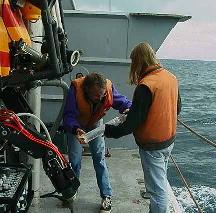
Dave Butterfield and Julie Huber retrieving samples from the fluid sampler after Dive 485. |
Frustration is an inevitable part of Oceanography, because any time you put something over the side of a ship at sea, it may not work or you might never get it back. This is particularly true when you have something designed to work at the bottom of the ocean - perhaps the most challenging engineering environment on Earth due to the corrosive conditions and the
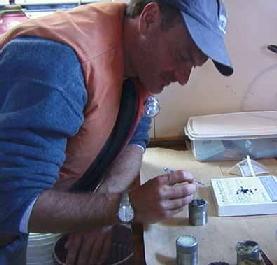
John Chadwick extracting rock chips from the wax cups at the bottom of the rock corer. |
Wecoma Science Report
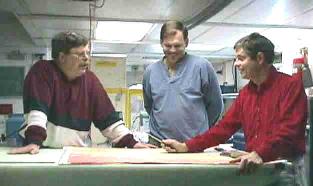 Chief Scientist Dr.
Ed Baker (right) reviews the distribution of operations over Axial
Volcano with Drs. Dick
Feely (left) and Joe
Resing (center) in one of the Wecoma's labs. So far at Axial the Vents
team has conducted eight "tow-yo"
operations and 16 vertical
CTD casts. These operations define the dispersal of hydrothermal plumes
away from Axial Volcano, allowing the scientists to estimate the rate
at which hydrothermal fluids are flowing from cracks in the floor of the
caldera.
Chief Scientist Dr.
Ed Baker (right) reviews the distribution of operations over Axial
Volcano with Drs. Dick
Feely (left) and Joe
Resing (center) in one of the Wecoma's labs. So far at Axial the Vents
team has conducted eight "tow-yo"
operations and 16 vertical
CTD casts. These operations define the dispersal of hydrothermal plumes
away from Axial Volcano, allowing the scientists to estimate the rate
at which hydrothermal fluids are flowing from cracks in the floor of the
caldera.
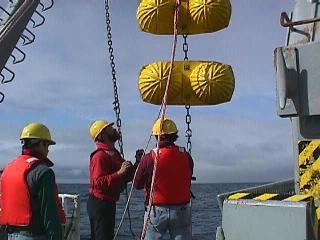 Vents scientists launch a CTD from the fantail of the Wecoma. The 1200
pound instrument and sampling package is lifted off the deck with the
Wecoma's winch, then carried out beyond the ship's stern with the moveable
A-frame overhead. The package is lowered some 1500 m (about 4500 ft) to
within a few meters of the seafloor, continuously sampling the temperature,
salinity, and optical turbidity of the water column. On the way back up,
the plastic sample bottles are closed to return water samples to the scientists
for detailed analysis.
Vents scientists launch a CTD from the fantail of the Wecoma. The 1200
pound instrument and sampling package is lifted off the deck with the
Wecoma's winch, then carried out beyond the ship's stern with the moveable
A-frame overhead. The package is lowered some 1500 m (about 4500 ft) to
within a few meters of the seafloor, continuously sampling the temperature,
salinity, and optical turbidity of the water column. On the way back up,
the plastic sample bottles are closed to return water samples to the scientists
for detailed analysis.
Listing of all Science News postings
Life at Sea: Participant Perspective
Jim Gendron
NOAA Vents Program
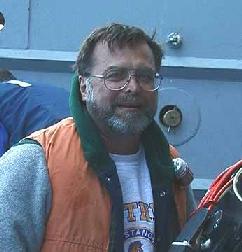 My name is Jim Gendron.
I am an oceanographer with NOAA's Pacific
Marine Environmental Laboratory in Seattle. I have been with the lab
for 19 years. My main interest in the VENTS program is to help further
the understanding of hydrothermal particulate matter. This includes trying
to determine how they form, and their distribution and chemical makeup
and evolution. I also have a strong interest in radon, a radioactive gas
that is found in very high levels in the vents.
My name is Jim Gendron.
I am an oceanographer with NOAA's Pacific
Marine Environmental Laboratory in Seattle. I have been with the lab
for 19 years. My main interest in the VENTS program is to help further
the understanding of hydrothermal particulate matter. This includes trying
to determine how they form, and their distribution and chemical makeup
and evolution. I also have a strong interest in radon, a radioactive gas
that is found in very high levels in the vents.
This work at Axial volcano is very exciting. I participated in the response cruise in February 1998, which was right after the original eruption. The samples that were collected then showed that very large particles had been blown high into the water column. When we visited Axial volcano last summer, the plumes over the volcano were reduced in volume and the average particle size was smaller. ROPOS did find lots of interesting activity on the bottom. So far this year the vent sites that we have visited seem to be more focused and at least one vent, somewhat warmer.
The main tools that we use to collect particulate matter with ROPOS are the fluid sampler that Dave Butterfield has developed and conventional Niskin samplers. The Niskins are PVC tubes that can collect about 5 liters of sample at once. The Niskins are then pressurized with nitrogen and the sample is pushed through a polycarbonate filter. We try to collect up to 500 micrograms per filter. The filters are then dried and when we return to the lab they are analyzed for 17 elements by X-ray fluorescence (XRF).
In general, eruptions such as the one at Axial volcano in 1998, release a very large amount of metals, especially iron, into the surrounding sea water. In addition, they remove a large amount of dissolved phosphate, which in the surface waters, is an important nutrient.
Listing of all Perspectives postings
Teacher At Sea Logbook
Day 10, Friday 6/25/99
During the evening hours we completed our data collection at Axial Volcano
caldera and moved to a new location. We are now located on the Cleft
segment at the southern end of the Juan
de Fuca ridge, almost due west of the homeport of our vessel, Newport,
Oregon. Systematic studies of the hydrothermal vents on the Juan de Fuca
Ridge originated here in 1980, only two years after the very first vents
were discovered in 1977 on the East
Pacific Rise. The northern Cleft segment, which we are studying today,
has been studied every year since 1986 by the Vents
Program. A "mega-plume"
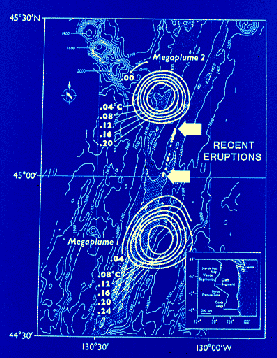 lava eruption in 1986 at this site produced great mounds of pillow lavas
and a new vent field. This eruption also releases a "mega-plume"
- enormous releases of hydrothermal fluid that rise a kilometer above
the seafloor - the first ever observed in the ocean (image right, click
for full size). The lava flows of the northern Cleft segment are distinctly
younger than the flows found elsewhere on the segment. Scientists estimated
them to be less than a few hundred years old.
lava eruption in 1986 at this site produced great mounds of pillow lavas
and a new vent field. This eruption also releases a "mega-plume"
- enormous releases of hydrothermal fluid that rise a kilometer above
the seafloor - the first ever observed in the ocean (image right, click
for full size). The lava flows of the northern Cleft segment are distinctly
younger than the flows found elsewhere on the segment. Scientists estimated
them to be less than a few hundred years old.
We will be taking two tow-yos along this segment. The first tow will be almost twenty-seven nautical miles with a duration of over 18 hours. There has been evidence of a decrease of hydrothermal activities and plume discharge over this site, suggesting that the system is continuing to cool down.
Dr. Joe Resing has mounted the "Submersible System Used to Assess Vented Emissions" (SUAVE) on the CTD rosette to measure concentration of Mn (Manganese), FeII (Iron) and H2S (Hydrogen Sulfide) for comparison with data from previous years. This instrument reacts with sampled water to form colors specific to the elements we are looking for. The concentrations are measured by the intensity of the color. This method is known as the colorimetric technique. The SUAVE has its own "personality". It has a bright yellow frame with a multitude of tubes, detector LED's (Light Emitting Diodes) and 12 plastic baby bottles with colorful cartoon designs. Even with its humorous exterior the SUAVE has been a significant surveyor for the scientists.
While working on the fantail of the Wecoma we were visited by a young male Northern Fur Seal. He swam about our ship entertaining us with his antics. He jumped in and out of the swells with great speed occasionally giving us a look with his cute dog-like face.
The activities on board go on like clockwork with the crew and scientists focused on the tasks to be completed. The lab and bridge is bursting with activity continuously 24 hours a day.
It is exciting for me to continue to spot whale blows on the horizon. Today I added Humpback whales to my list of cetaceans documented. These were easily identified due to their bumpy rostrum, rorqual streaks, blowhole placement and dorsal fin. The largest of the two was near fifty ft. in length, while the smaller was between twenty five and thirty ft. I continued to search the horizon for additional sightings.
Check the NeMO site tomorrow.
Fair seas
Ms. Deck
Teacher Log #6 6/25/99
The major component of Dive 485 was the collection of vent fluid using the specially designed Vent Fluid sampler. This device is designed to collect up to fourteen 800 ml containers of vent fluid from specifically targeted places within the vent fluid stream. This allows for a discrete sample at a known temperature. The sampler is built to fit the ROV just below the body and towards the front so the sampler is visible during the operation. The actual collecting probe is fitted to one of ROPOS arms for placement accuracy. The sampling operation during todays dive was successful.
When ROPOS is in action down along the ocean floor, many of the scientist and technicians are viewing the actions on monitors placed around the ships labs. During the ascent back to the ship, those with samples on the way to the surface begin preparation for necessary lab work to be done. Samples of vent fluids and biological materials are required for their research, so when these samples finally reach the deck, the sense of urgency takes over as the "shelf life" for these samples is quite limited. No sooner then it takes to tie off and secure ROPOS and its cage, samples are whisked away into the respected lab areas.
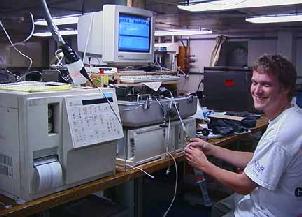 Andy Graham running gas chromatograph samples |
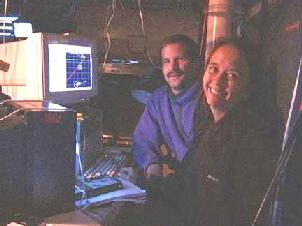 Bill Chadwick and Susan Merle manning the ROPOS navigation center in the main ROPOS control station |
Logbook of all Teacher At Sea postings
Questions & Answers
(oar.pmel.vents.webmaster@noaa.gov)